 This is a Smena (Смена) 4, a 35mm compact camera made by GOMZ in Leningrad, Russia and was produced between 1958 and 1960. It was the 4th in the Smena family of cameras, and the last to be produced with this body style, made entirely of Bakelite. The camera was designed for cassette to cassette film transport, and featured a simple 5 speed shutter, flash synchronization, and a self-timer, it was a capable, but entry level camera. The Smena name would be used in a countless number of submodels and variants produced until after the fall of the Soviet Union.
This is a Smena (Смена) 4, a 35mm compact camera made by GOMZ in Leningrad, Russia and was produced between 1958 and 1960. It was the 4th in the Smena family of cameras, and the last to be produced with this body style, made entirely of Bakelite. The camera was designed for cassette to cassette film transport, and featured a simple 5 speed shutter, flash synchronization, and a self-timer, it was a capable, but entry level camera. The Smena name would be used in a countless number of submodels and variants produced until after the fall of the Soviet Union.
Film Type: 135 (35mm)
Lens: 4 cm f/4.5 T-22 (Triplet) Coated 6-elements
Focus: 1.3 meters to Infinity
Viewfinder: Scale Focus
Shutter: Leaf Shutter
Speeds: B, 1/10 – 1/200 seconds
Exposure Meter: None
Battery: None
Flash Mount: Coldshoe and Flashbulb Sync
Weight: 290 grams
Manual: None
How these ratings work |
The Smena-4 was an entry level Soviet camera aimed at the beginning photographer in the mid to late 1950s. The fourth model in the long lived Smena series, it had a body made entirely out of Bakelite, a simple scale focus viewfinder, 5 speed shutter, and was designed for cassette to cassette film transport. The simple T-22 “Triplet” lens is capable and makes images consistent with it’s entry level “point and shoot” design. Although this camera won’t wow you with razor sharp photos, you could do a lot worse. Despite it’s humble specs, the camera is quite handsome and looks like no other Soviet camera. You could do a lot worse with other entry level cameras made over the past 100 years. | ||||||
| Images | Handling | Features | Viewfinder | Feel & Beauty | History | Age | |
| 0 | 1 | 1 | 1 | 2 | 0 | 30% | |
| Bonus | none | ||||||
| Final Score | 6.5 | ||||||
History

The Smena series was made in the city of Leningrad, Russia in the GOMZ factory. GOMZ is short for Gosudarstvenniy Optiko-Mekhanicheskii Zavod which translates to State Optical-Mechanical Factory. Established in 1914, it transitioned to optical production in 1930 as one of the first Soviet factories to produce cameras and lenses. One of it’s first products was the folding Fotokor-1, which was an inexpensive copy of a German 9×12 folding camera, but in the years that would come, GOMZ would produce a dizzying array of models. Most GOMZ cameras were of the inexpensive variety which allowed them great success at introducing photography to the masses in the Soviet Union.

In 1939, GOMZ would release a camera with an all Bakelite body and a front “scissors” folding design called the Smena (Смена) which strongly resembled the Kodak Bantam. Designed by Ilya Grigoryevich Shapiro who was responsible for several other cameras including the later GOMZ Leningrad, the original Smena (which loosely translates to ‘change’ or ‘shift’) featured several improvements over the Bantam including a more versatile shutter, a focusing lens element, and a different viewfinder. Despite being a novel little camera, the original Smena was not in production long, likely due to Russia’s involvement in the war.
The GOMZ factory’s location in Leningrad spared it from destruction during the war, so once it had ended, GOMZ was one of the first Soviet factories to resume producing cameras and optical products.
In 1953, Ilya Grigoryevich Shapiro would once again release an inexpensive Bakelite 35mm camera using the name Smena, but this time, it was an all new design. Why was the name “Smena” used once again for an entirely different camera? On his site sovietcams.com, author Aidas Pikiotas hypothesizes that the release of the new Smena coincides with the death of Joseph Stalin and could have been seen as a “Change” in leadership, or it could have just been a coincidence. Whether any of that is true or not, is anyone’s guess and we’ll likely never know.
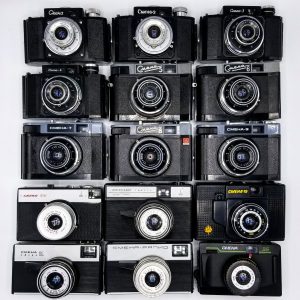
Over the next few years, the Smena would be continuously updated with additional features such as flash synchronization, a self timer, improved film advance levers, and improved shutters. An unofficial “first generation” of Smena cameras would last through the Smena-4 before being replaced by the all new Smena-5.
In 1962, the GOMZ factory would be reorganized as the Leningrad Optical-Mechanical Association, or LOMO for short, which is the name it still uses today. In the decades that would follow, a huge number of Smena branded cameras along with Smena variants such as the Vesna and Zenit-35F would be released. Although the look and design of the Smena series would constantly evolve, a common entry level feature set would remain. It is estimated that in total, over 30 million cameras were produced with the name “Smena” throughout it’s production run making it one of the most successful marques in the camera industry.
Today, Smena cameras aren’t the most collectible of cameras, but I personally think the early models like this Smena-4 have a unique attractiveness to them. I appreciate the fact that unlike so many other Soviet cameras, these aren’t copies, or even inspired by anything released by some other company. I can’t say whether or not other collectors would share my fondness for them, but it’s at least something to consider if you were looking for another type of camera to collect.
My Thoughts
I mention in the above History section that over 30 million Smena were produced throughout the entire production run, so it probably is no surprise to know that a few have crossed my path while collecting. Believe it or not, I do not just buy every camera that I come across. My wife may not believe this, but there are many that I see in Goodwill shops or at garage sales, and (gasp) even eBay that I don’t buy.
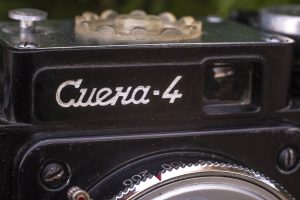
My resistance can be easily overcome however, when the price is free. Such was the case of this “Franken-Smena” as it was referred to by it’s previous owner. For those of you who are keen-eyed shoppers, you might have noticed that this Smena-4 doesn’t look like every other Smena-4 out there. Whether you noticed this ahead of time or not, I’ll cut through the suspense and tell you that this is a Smena-4 body with what looks to be a chrome faced Smena-2 shutter and lens. Normally the shutter and it’s lens should be painted black, but not here. This combination of a Smena-4 body with an earlier shutter was likely done by some previous owner to combine two broken cameras into one good one. Whoever made such a “hybrid” obviously knew what they were doing as this camera works correctly.
The Smena-4 is quite compact, but has a solid Bakelite body with quite a bit of heft to it. If you’ve never held a Bakelite camera before, think of it like a very dense, but brittle plastic. Had this exact camera been made out of modern injection molded plastic, it likely would have weighed at least a good 50-100 grams less. The body does not flex or creak in your hands when held, and even though it would likely crack when dropped, it gives the impression of something you wouldn’t want to drop on your toes without shoes on.
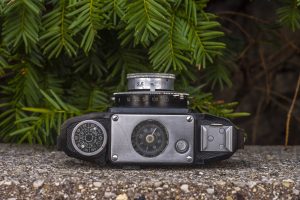
From the top plate, we see the film advance lever which is operated with your left thumb, and a film reminder disc which has numbers conforming to both the DIN and Soviet ГОСТ (GOST) scale. The GOST scale uses an arithmetic numbering system which was similar to the ASA scale, differing only by a factor of 0.1 so for example, GOST 90 is the same as ASA 100, 180 is 200, and so on. In the center is an exposure counter with a see through plastic disc which is used to reset the counter. The plastic used on these Smenas usually shows signs of age and can sometimes be hard to see through. Next to it is the rewind button, and finally the accessory cold shoe.
Also visible from the top of the camera when looking down at it are the shutter speeds and focus scale on the front lens element. Although not a waist-level camera, it is convenient to be able to see the selected shutter speeds and focus distance without having to look at the front of the camera.
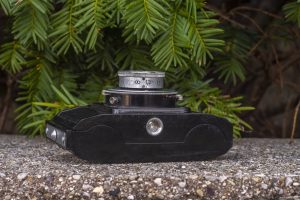
The bottom of the camera is quite barren, featuring only the 3/8th inch tripod socket. Like most Soviet cameras, you cannot use a modern tripod designed for 1/4th inch bushings without an adapter. Not really a feature, but you can see two curved cutouts on the bottom of the camera that hide openings for both the take up and supply sides of the film compartment which aides in installing film.
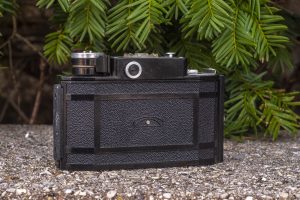
The back of the camera continues the spartan theme from the bottom featuring only the small viewfinder with a knurled chrome ring around it which looks like it might be some sort of adjustable diopter, but it’s not. Spinning it on mine did nothing. The viewfinder itself is a simple straight through window with no frame lines, no parallax marks, no information about the shutter, literally nothing.
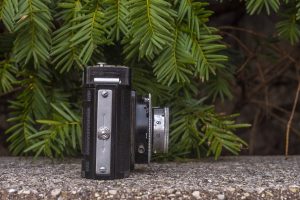
To open the rear of the camera, you need to slide the catch on the camera’s right side to release the lock. The entire back of the camera comes off after doing this, so be prepared for that, and don’t drop it as the brittle Bakelite would likely crack.
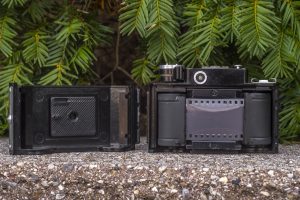
The film compartment on the Smena-4 is designed for a cassette to cassette system which means there is no ability to rewind the film after you reach the end of a roll. Film travels from right to left and the previously mentioned notches on the bottom of the camera make loading new cassettes easy.
The example here came to me with both cassettes loaded with some type of mystery film that I was unable to use. You don’t need special “Smena cassettes” as any metal or plastic reloadable cassette will work for bulk film.
If you aren’t interested in bulk film, or don’t have any reloadable cassettes, don’t worry as a normal pre-loaded store bought cassette fits on the right (supply) side, and the center spool of a standard 35mm cassette will work as a take up spool on the left, you’ll just need to tape the leader to the spool when loading. It also might be a good idea to put some tape along the door seams for additional light protection after closing the camera. Remember that there is no way to rewind film back into the spool after you reach the end of the roll, so you’ll need to open the camera in darkness and rewind it yourself.
That’s about all there is to it. The Smena-4 is a humble camera with humble aspirations. It’s neither basic, nor complex. It was a point and shoot camera for Soviet families who wanted to capture moments on film, but weren’t yet ready to fork over the roubles for a Zenit!
My Results
For my first roll through the Smena, I decided to use some expired Kodak Gold 200 that I had in my film drawer. I had a feeling the shutter speeds were a bit sluggish on this camera so I wanted something I could shoot at around ASA 100, but didn’t want to waste any of my “good” 100 speed film like Ektar so I went the expired Kodak Gold route.
It would turn out that this proved to be a wise idea as my inaugural roll through the camera was met with a couple of problems.
Before I get to the trouble I had using this camera, I’ll start with the good. Soviet optics range from quite good to quite poor, and the vaguely branded T-22 “Triplet” f/4.5 lens didn’t exactly inspire confidence in it’s optics. The Smena-4 after all, was always intended to be an entry level camera for the beginning photographer. I never could find any info about how much it cost new, but it I’m sure it was comparable to simple cameras like the Kodak Pony or ANSCO Silettes sold in the United States around the same time.
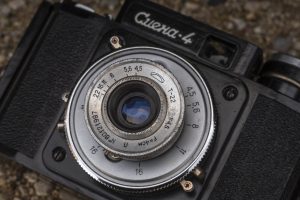
With that in mind, the sharpness of the lens is pretty good, especially in the center. There is sharpness fall off near the edges, but once again, it’s not bad. Look at the 2nd image in the gallery above of the church steeple and you can still make out the detail of the brickwork on the far left side of the frame. There is vignetting, but I’ll repeat myself again, it’s not bad. This was clearly an economy camera, and with that, you should expect economy results, and I think that’s what it delivered.
Now for the bad. Every image I shot had light leaks. This camera has a solid Bakelite body with deep channels around the door. There were no cloth or yarn light seals on the camera and I used the original cassette as a take up spool, so the film should have been reasonably protected, yet the leaks are still there, which suggests they likely came from the lens area. I took a quick look through the film compartment of the camera in bright light and couldn’t see any obvious leaks. I have no idea where they came from, but thankfully they didn’t ruin the images.
Sadly, the shutter stopped working after the 8th or 9th exposure and I couldn’t get it to fire any longer. Without any ability to rewind the film, I had to open it at home in the darkness. I decided to cut the film and develop what I could and save the rest for another camera. I had planned on trying to free up the shutter on this camera for a second roll, but just never got around to doing it. Although I generally like to include more than 6 samples in a review, I feel there’s enough to get an idea of what to expect from the Smena-4.
Can I recommend the Smena-4? At the right price, sure! There are many cameras out there with far worse image quality or that are far more difficult to use than this. It is quite a handsome camera, and I think in the right circumstances, the images really aren’t that bad. It doesn’t look like any other Soviet or non-Soviet camera ever made. I enjoyed my time with this thing, but can’t exactly say it left me looking forward to it’s next roll. Even if I had no problems with the shutter, this camera would likely have sat on my shelf for a long time.
Additional Resources
http://sovietcams.com/index.php?344164537
http://camerapedia.wikia.com/wiki/Smena-4
http://ussrphoto.com/Wiki/default.asp?WikiCatID=71&ParentID=1&ContentID=282
http://oldcameracollection.blogspot.com/2015/06/smena-4-some-more.html

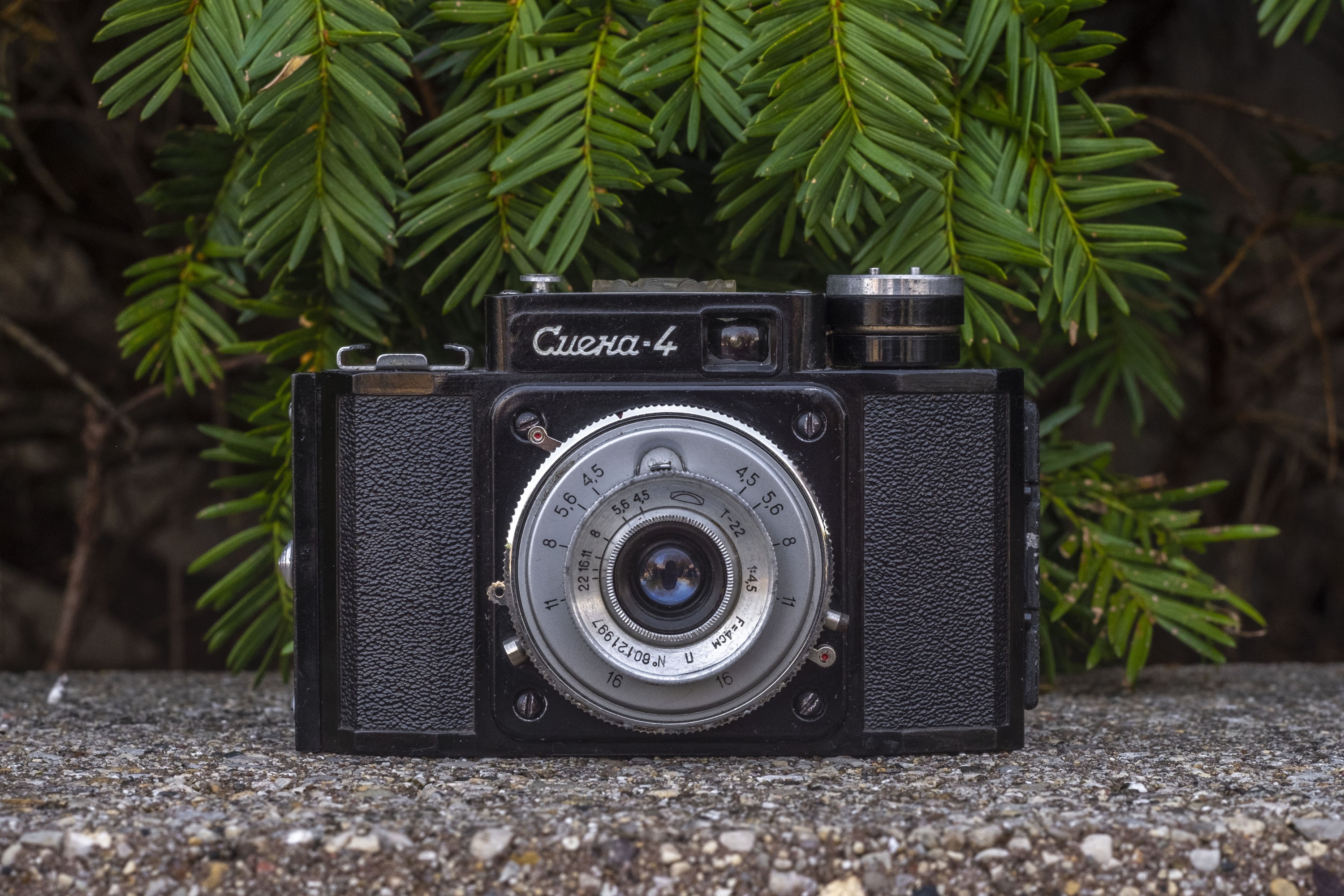
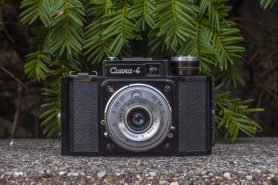






My first 35mm camera was a Cosmic 35, same model as the third row of the camera collection image. I persuaded my dad to buy it for me in 1966 !!! It was surprisingly good for what it was. I bought a little Stitz exposure meter for it that fitted on the flash shoe.The shutter eventually stopped working, I picked up another example a couple of years ago.
Ive seen a few of those Cosmic 35s. Vladislav has a few in his collection. I’d like to someday try a later Smena, but for now, this Smena-4 scratched that itch! 🙂
This Smena was made at BelOMO — Belorussian optical-mechanical union. That explains different from usual 4 model appearance.
Thank you for the clarification, Nikita!